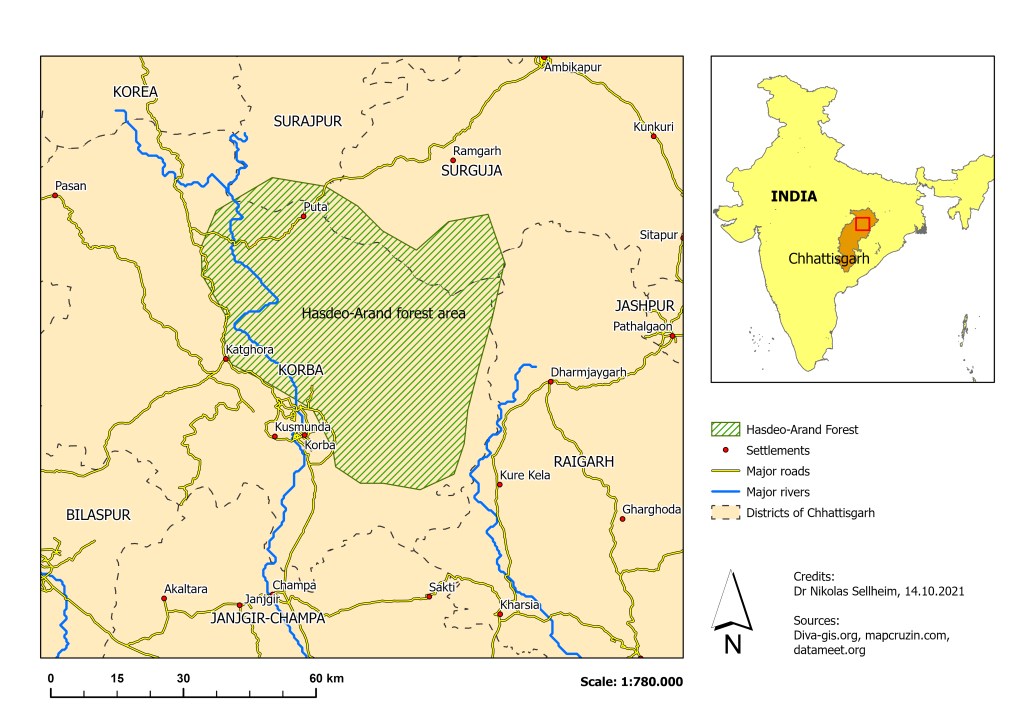Introduction
In early October 2021 India’s minister for power, new and renewable energy, R.K. Singh, informed the public that the current demand for power in his country has exceeded the usual post-monsoon demand from earlier years (here). Several new outlets have picked up on this problem since this would lead to potential power outages in India’s most populated areas (here).
According to numbers presented in India Today, the country’s largest coal supplier, Coal India Limited (CIL), has produced 249.8 million tonnes of coal vis-à-vis a demand of 307.7 million tonnes between April and September 2021. This is 13.8 million tons of production more than the year before with an increase of more than 55.2 million tons in demand (here).
In light of this increase in demand, the Indian government has announced that it would expand its coal mining programmes. New mines are to be opened in the Hasdeo-Arand forest region in the state of Chhattisgarh in central India.
In this blog post I will touch upon the expansion of India’s coal industry and the pledge of Prime Minister Narendra Modi to protect the climate. Particular attention is paid to the impacts of coal expansion on the country’s indigenous peoples, particularly in the Hasdeo forest.
The Prime Minister’s environmental pledge
The participants of the 13th Conference of the Parties (COP) of the Convention on Conservation of Migratory Species (CMS) in Gandhinagar in February 2020, which I also had the pleasure to observe, quickly gained the impression that India’s environmental policies would pay ample regard to the protection of biodiversity and indigenous and local communities. In a live video stream the Prime Minister remarked that the cultural ethos of India demanded for the conservation of wildlife and habitats (here, para. 9) and that the conservation and improvement of the environment is even enshrined in the Indian Constitution (here, article 48A).
At the same meeting he noted that India is one of the few countries in the world that comply with the Paris Agreement on climate change (here, para. 9) – a claim that he reiterated at the last meeting of the UN General Assembly. In his speech, he noted that India is rapidly moving to reach 450GW deriving from green energy while aiming to make India the “world’s largest green hydrogen hub” (here, at around 14:20).

In a book that Modi published in 2015 (here), he outlines his environmental ethics and the path he aims to tread to make India’s economy green. Especially the transition from fossil fuel-based energies to renewables constitutes a core element of the book. By providing some data on the processes in this regard, the book aims to convince the reader of the success of Modi’s policies. Not surprisingly, the book was distributed for free at CMS COP13.
It would consequently appear reasonable to assume that India’s performance concerning the phasing out of coal and the associated reaching of its own National Determined Contributions (NDC) – bottom-up requirement under the Paris Agreement – as well as the country’s effort to conservation regions of rich biodiversity is quite high. As we will see, this is far from the truth.
Facing reality
Climate change mitigation
The data produced by the independent scientific work of the Climate Action Tracker (CAT) paints a rather grim picture. Here, India’s policies are labelled as ‘highly insufficient’. It is estimated that due to the massive expansion of coal extraction, by 2029-2030 India’s coal-based energy production will increase from 200GW to 266GW, of which 35GW will go online in the next five years, which would amount to an increase of 17,5% of coal production (here).
India’s NDC consists of three elements:
- An emissions-intensity target of 33%–35% by 2030 below 2005 levels;
- To increase the share of non-fossil-based energy resources to 40% of installed electric power capacity by 2030 with support;
- To create an additional (cumulative) carbon sink of 2.5–3 GtCO2e through additional forest and tree cover by 2030.
While the country, according to CAT, needs to moderately adjust its policies to reach its NDC, the international target of limiting global temperature increase by 1,5°C requires India to substantially improve its policies. After all, India has one of the largest coal energy pipelines in the world and its coal expansion are not consistent with the gradual phasing out of fossil fuel-based energy production (here).
The Hasdeo-Arand forest area
In order to meet the growing demand for coal, India has consistently expanded its mining operations. One of the areas now once again under consideration for coal mining is aforementioned Hasdeo-Arand forest area in the south of the districts of Surajpur and Surguja and in the northern regions of Korba in the state of Chhattisgarh in central India.

The Hasdeo-Arand forest area is a densely forested area on top of a surveyed coal field of around 1878 sq km, of which 80% are covered by forest. The forest is extremely rich in biodiversity and is home to several endangered species and amounts to around 1,7million hectares. An elephant corridor furthermore spans through the area, even though the Indian government has not officially recognised this (here). Despite its richness in biodiversity, the Hasdeo-Arand forest area has not been declared a protected area by the Indian government.
The area is home to numerous Adivasi communities (‘Adivasi’ is a collective term for India’s indigenous peoples), who are dependent on agriculture and forest produce. The towns and villages of the Adivasi are situated on lands that have been identified as 18 distinct coal blocks. Since 2014, the Indian government has started to auction these blocks. Of these 18, two are actually mined while the State Government of Chhattisgarh has proposed to the Central government to open up 3 more in 2018. At that time, already 4 more were under consideration to be opened up for mining (here). This, despite the fact that already more than 10 years ago, the Ministry of Coal and the Ministry of Environment, Forests and Climate Change (MoEFCC) conducted a joint study on the surveyed coal areas in the area. In the wake of that study, all of the surveyed coal blocks were labelled ‘no-go’ areas, amounting to more than 45,000ha (here). However, in 2011, the first of these areas was opened up for mining, to become the Parsa East Kete Base (here). Of other ‘no-go’ areas, seven are now to be auctioned again, effectively stripping them of their status .
The plights of Adavasi communities in the Hasdeo-Arand area
Since the State Government of Chhattisgarh has opened up the coal blocks for auction, the problems for the region’s Adavasi communities have increased. In Chhattisgarh, based on the 2011 census, amounting to a population of almost 8 million people around one third of the population are in fact Adavasi (here). Since there are several hundred Asian elephants (Elephas maximus, endangered) in the region, human-wildlife conflict has been inevitable. This has led to numerous elephants having been killed while also Adavasi were killed. In order to reduce this conflict, in 2007 the Lemru Elephant Reserve approved by the government of Chhattisgarh. Originally delineating an area of 450 sq km, in 2019 it was decided to expand the area to 1,995 sq km. However, in 2021, the area was to be reduced to 450 sq km again.
While the Lemru Reserve has never been implemented, the proposed reduction in size occurred parallel to the auctioning of the coal mines. This is due to the fact that several of the coal blocks would be within the reserve, which would render them unusable, according to Indian legislation. And this the State government of Chhattisgarh aims to prevent.
The Adivasi communities are therefore caught between a rock and a hard place. On the one hand, an elephant reserve would clearly delineate areas that are clearly off limits for agricultural or other use. While this might reduce human-wildlife conflict, it would also translate into less traditional lands to be used for traditional purposes. Even worse, the establishment of the reserve could also lead to forced displacement of the local communities (here).
Although the reserve has not been established yet, consequently making the allotted lands de facto usable for the Adivasi communities, the auctioning of the coal blocks places yet another burden on the Adivasi. After all, the lands and forests are lost to big mining companies. And the environmental effects of mining are manifold: air is polluted by dust, water resources are dried up and entire landscapes are altered, just to give a brief indication (here).
With the new auctions of former ‘no-go’ areas in Hasdeo-Arand, it does not come as a surprise that several hundred villagers took to the streets to protest this move. These protests are also to be taken to the state’s capital Raipur in a 300km march (here). This is not surprising. After all, so-called ‘Scheduled Tribes’ are recognised indigenous peoples in India. In 2006, the Scheduled Tribes And Other Traditional Forest Dwellers (Recognition Of Forest Rights) Act (‘Forest Right Act‘) was adopted. This act inter alia stipulates the right to ownership, land use and access. However, one must bear in mind that the language of the act uses derogatory terms such as “primitive”. The auctioning of the Hasdeo-Arand coal blocks is consequently a violation of the rights under the Forest Right Act.
All in all, while India has supported the UN Declaration on the Rights of Indigenous Peoples (UNDRIP), it has shown inertia or even reluctance towards implementing these rights. Mining probably constitutes one of the greatest threats to India’s indigenous peoples: for instance, 400 families of Kawar Adavasi in Chhattisgarh were displaced due to mining. (here).
Conclusion
In light of the Prime Minister’s pledge to conserve the environment and existing rights of indigenous peoples in India, the unique Hasdeo-Arand forest area is gradually further opened up for coal mining. While from an energy standpoint this is understandable, particularly in light of the economic costs stemming from the COVID-19 pandemic, it comes at a huge cost: first, the region’s indigenous communities are ever more deprived of their traditional lands and therefore of their livelihoods. Second, unique habitats and biodiversity are facing severe challenges when mining operations start taking off. Third, India expands an industry which contravenes the country’s commitments under the Paris Agreement.
This example shows once again how the interplay of economy, indigenous rights, biodiversity conservation and climate protection are difficult to be brought under one umbrella. In the end, it seems, it is the coal industry which will be the victor, supported by both the State government of Chhattisgarh and the Modi government. Whether this will lead to displacement of Adivasi remains to be seen, but blocking lands for indigenous communities constitutes a gross violation of prevailing Indian legislation. Also India’s climate change mitigation policies will not benefit from this move.
Acknowledgement
Thank you to The Hasdeo Valley (Twitter: @hasdeo_valley) for the support.
